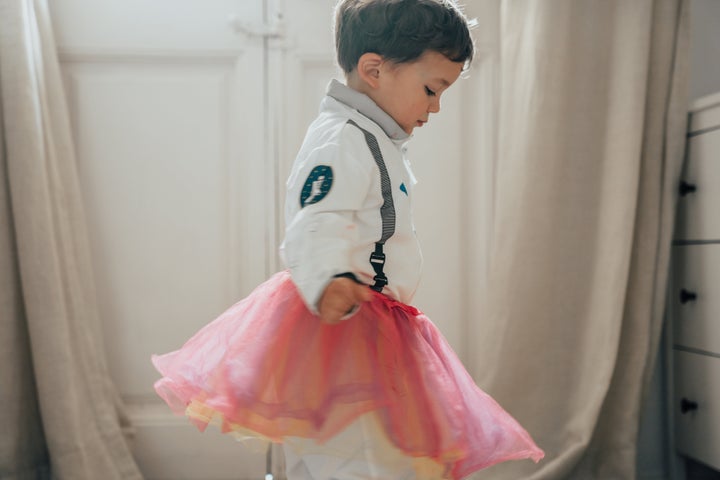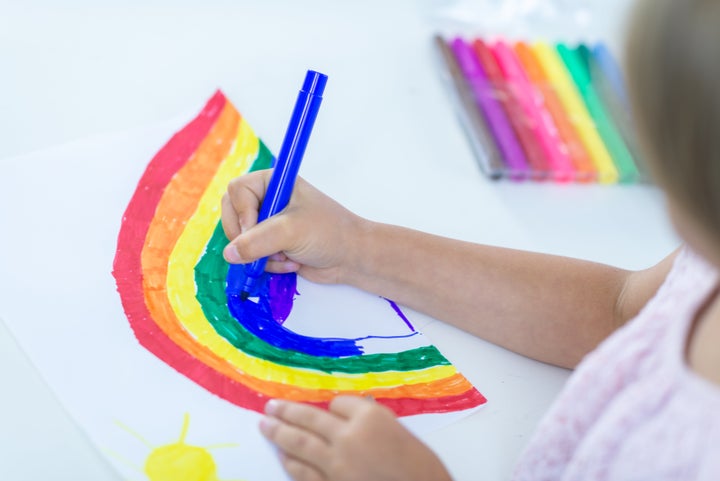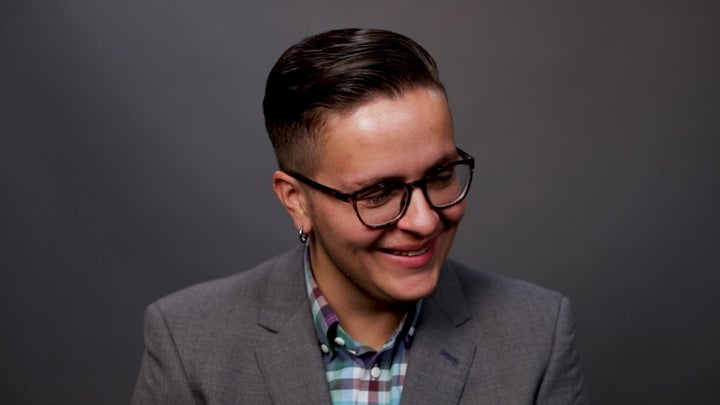
Last year, Jack’s grade two classroom had a substitute teacher who used a classic strategy to divide the class up for an activity: “Boys over here, and girls over here.”
In an act that likely brought that teacher to acknowledge some unconscious assumptions, Jack marched right into the middle of the two lines and exclaimed, “And boy-girls in the middle!”
Jack’s mom, Morgan Caswell of Calgary, sometimes calls him non-binary or gender creative, but in general, she doesn’t define his identity — because neither does he at the moment. Whether Jack dresses in a bow-tie or a sequined skirt (both of which have been favourite accessories), one thing she does know is “there aren’t any other kids like Jack in his school.”
While they still have work to do, Caswell says she’s been pleased overall with how staff at the elementary school have responded to Jack’s non-traditional gender identity and performance.
Watch: Gender stereotypes hurt us all. Story continues below.
How ECEs are helping
Early childhood educators (ECEs) work with children under six years old in settings like daycares, preschools, or kindergarten classes, and are increasingly called on to welcome gender-creative or transgender children and queer families.
“It’s so important to be doing this work, whether or not you know there are 2SLGBTQ families or children in the centre,” j wallace skelton, a PhD candidate at the University of Toronto’s Ontario Institute for Studies in Education, told HuffPost Canada. “It’s good for everyone.”
“Early-years spaces can feel really gendered and really heterosexual,” said skelton, who is working with the city of Toronto to make Early ON centres more inclusive of sexual and gender diversity.
Symbols can go a long way; starting points include safer space stickers, gender and sexual diversity represented in books and posters, and anti-discrimination policies in prominent places. But, “a welcoming environment needs to go beyond signalling and also needs to demonstrate that 2SLGBTQ+ children and adults are welcome and valued,” skelton added.
Whether the early-learning space is a kindergarten, a preschool, or a daycare, meaningful actions can let families and children know their identities are valued. Seeing “parent” instead of “mother/ father” on paperwork is important, as well as having teachers remember parenting titles, whether that’s “papa” and “dad” or “deedee” and “baba.”

Crystal Trumper of Toronto is appreciative of her family’s kindergarten experience. Their oldest daughter, who is now eight, is adopted and has Down syndrome — these factors plus having two moms made for “quite a bit of difference,” so the family wasn’t sure what to expect.
But Trumper says they’ve felt nothing but support.
“At Christmas, [our oldest daughter’s] card and gift to us were addressed to mommy and momma, on Mother’s Day they took the time to make two gifts,” Trumper said.
The onus is often still on parents to promote inclusion
Even though same-sex parents are becoming more visible in mainstream culture, many feel the onus still often falls on them to source inclusive classroom resources, or advocate for more LGBTQ2+ celebration.
Mahalia Freed lives in Vancouver with her wife and two young children, and says their daycare centre is generally quite good about her family structure, but she’d love them to take more initiative.
“They didn’t read any special books (like Heather has Two Mommies, or Mommy, Mama, and Me) for Pride,” she told HuffPost Canada.
“But maybe they would have if I had brought in the books?”
skelton encourages early childhood education centres “to go a step further and think about becoming celebrating environments.” Read diverse books all year long, have a Pride party, invite drag queens in to read; not just when there’s a (known) LGBTQ2+ family or student in the classroom, and not only at the request of the families themselves.
WATCH: Why we all need drag queen story hour in our lives. Story continues below.
While Jack’s school has moved beyond tolerance to acceptance, Caswell says, “they have definitely not moved into radically embracing.” The difference between being accepted and embraced might seem like semantics — but according to OISE professor Tara Goldstein there is a universe of difference between these attitudes.
Moving from acceptance to support
“In some education training programs, we hear the word “tolerance” used in discussions about supporting LGBTQ families, children and youth in schools,” Goldstein told HuffPost Canada.
“But families don’t want to be tolerated. They want to be expected, welcomed, accepted, and supported for who they are.”
Goldstein is the author of Teaching Gender and Sexuality at School: Letters to Teachers and recently conducted a research study called The Experiences of LGBTQ Families in Ontario Schools.
One parent she interviewed explained that “‘tolerance’ means, ‘OK, well, I’ll sit beside you.’ ‘Acceptance’ means, ‘I’ll put my arm around you.’ But ‘support’ means, ‘I’ll lift you up when you can’t get up.’”
A space kids can look forward to going
Lee Airton is an assistant professor of gender and sexuality studies in education at Queen’s University, and would like to see classrooms be spaces where children can relax and feel comfortable.
“That’s very different from being told that this is a space that is welcoming. This is much more visceral. This is a space where I look forward to going ... I can make friendships with the knowledge that people will not turn away from me once they discover who I am. If I need help, I know I can ask an adult in a space,” Airton said.

Removing references to gender or gendered play entirely would go a long way in creating this kind of atmosphere, Airton added. While the task can seem daunting, they recommend prioritizing two or three action items this year.
Perhaps “share your pronouns with kids and parents as that arises. Resolve to never say ‘boys and girls,’” and when teachers see gender policing going on, “You can resolve to always intervene skeptically and constructively.”
Ultimately, it’s important for teachers and care providers to remember how important they are to the children they support. By showing each child that they and their family are welcome and celebrated in the classroom, Morgan Caswell says that “teachers have the power to show kids that they can be whatever they want to be.”
Resources for educators:
- Building Bridges: Queer Families in Early Childhood Education
- Creating a Welcoming Early Childhood Program for LGBT Families: A Checklist for Programs
- The Gender Friendly Classroom
- Gender in the Early Childhood Setting
- Guidelines for Supporting Transgender and Gender Non-Conforming Students in the Classroom
- Welcoming and Celebrating Sexual Orientation and Gender Diversity in Families from Preconception to Preschool
- LGBTQ Families Speak Out